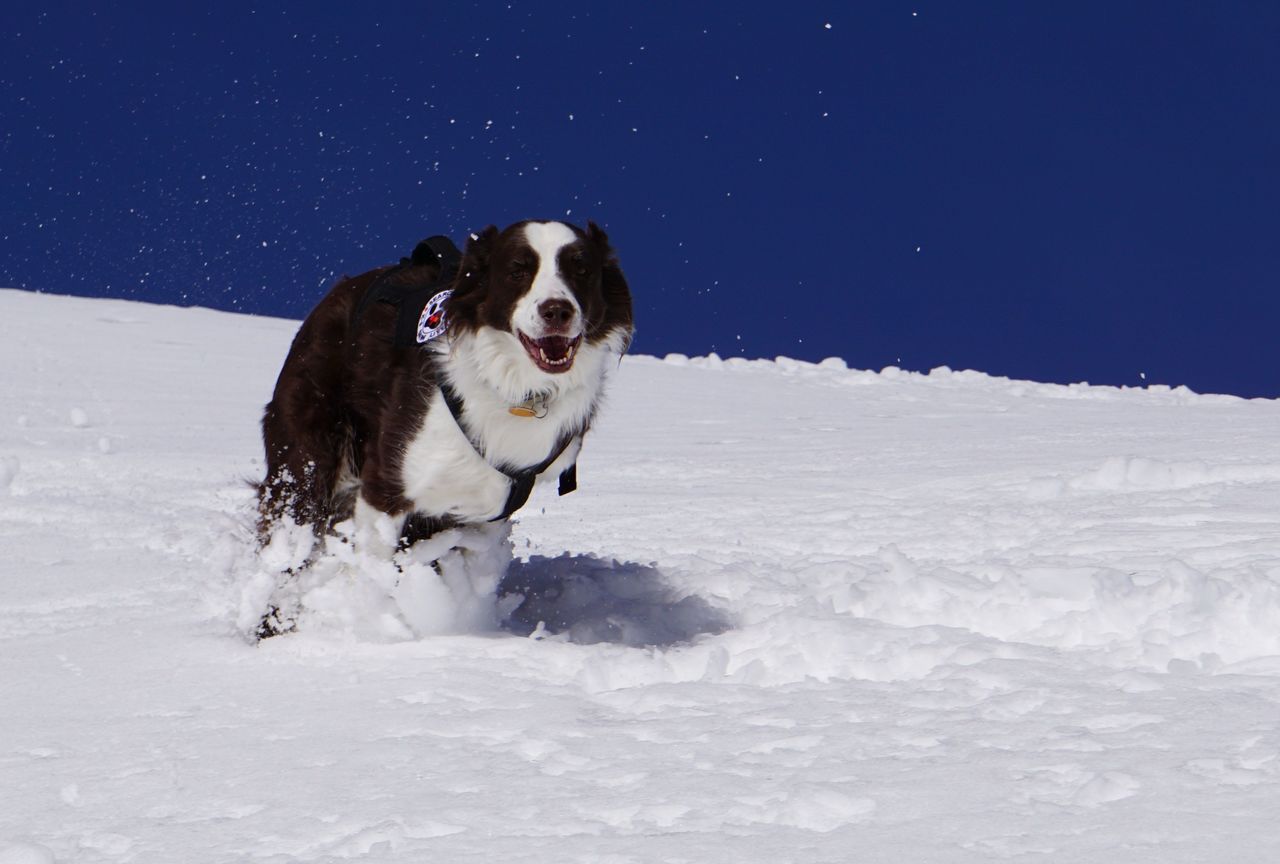DONNELLY, Idaho — Wylie’s presence at the Tamarack Resort ski area serves as both comfort and warning sign.
The 9-year-old Australian shepherd is trained to quickly find a person buried by an avalanche — but the fact that he’s needed should tell you how serious the avalanche threat is in the mountain’s out-of-bounds areas.
Those areas are easily accessible and backcountry skiing is part of the Tamarack experience, but the Ski Patrol team implores skiers and snowboarders to bring four potentially life-saving items with them: a buddy, avalanche beacon, shovel and probe. The out-of-bounds areas don’t receive avalanche mitigation.
“Our situation here is unique because we have lift access to the backcountry that is so easily accessible,” said Colin Gamble of Donnelly, a Ski Patrol member and Wylie’s owner/handler. “We’ve had multiple calls where people have gotten buried up to their chest or their neck out in Wildwood Bowl. We’ve had at least 10 of those since we opened (in 2004).”
That’s why Tamarack has kept an avalanche-rescue dog on hand since it opened. Sun Valley Resort also has a dog program.
Tamarack hasn’t needed to use its dogs for a rescue yet. The Ski Patrol has responded to a few emergencies but the skiers’ friends were able to dig them out before the pros got there. The dogs also have searched where a slide path made it impossible to tell if someone was trapped.
Grand Targhee Resort in western Wyoming recently used an avalanche-rescue dog to find a man who died in an avalanche. He stepped under a boundary rope onto a cornice, which broke, according to the Teton Valley News. The resulting slide carried the victim over a cliff. The dog found him in 2 feet of debris. The man died from injuries sustained in the fall.
Gamble previously worked with a patroller who had an avalanche-rescue dog in Colorado. He got Wylie at 3 months old with the intent of training him as an avalanche rescuer.
Any working or retrieving dog can succeed, he said.
“They love it,” Gamble said. “For the most part, for them, it’s a game. As soon as you walk out and grab your skis, he’s excited.”
Wylie is one of four dogs in the Tamarack program. Mac, a 4-year-old blue heeler mix, has trained for two years. The other two are puppies in training.
Wylie is the veteran — and he’s good at his job.
The Tamarack patrol crew staged a training run for Wylie last week with patroller Ben Hathaway of Donnelly buried in the snow.
“I trust Wylie,” Hathaway said as the snow was piled at the entrance to his cave. “I watched him do this the other day. He was pretty amazing.”
After 10 minutes, Wylie was called in to search. He ran immediately to the spot where Hathaway was buried.
After sniffing around a bit — and taking a potty break — he started digging in the snow. Gamble helped with a shovel.
Hathaway was out of the hole less than 2 minutes after Wylie was released.
“For the dogs, it’s relatively simple,” Gamble said. “In an avalanche slide path, it’s pretty much wiped clean of most scent. If someone is buried there, they see this giant scent cone, if you will, and they can see that right off. An avalanche dog can do the work of 20 people in 5 minutes. So a half an hour of 20 people searching, an avalanche dog can do that same area in about 5 minutes. It greatly increases our speed, especially if they’re not wearing proper avalanche gear. The first thing we would do is look for an avalanche beacon.”
A live training exercise is particularly easy for the dogs because so much scent remains outside the hole, even with the 10-minute waiting period. A better test, Gamble said, is to bury a piece of clothing and search for it the next day.
“They’re pretty darn accurate,” he said. “A deep burial, more than 10-15 feet, the scent comes up the path of least resistance through the snow, so where they’re scenting may not be exactly where the person is buried, so you have to reorient them in the hole as you dig down.”
Speed is critical in an avalanche rescue. After 15 minutes, survival rates plummet.
Tamarack’s dogs stay in the Ski Patrol building at the summit, not far from the avalanche danger zones.
“Aid from people you’re skiing with is the primary thing,” Gamble said. “If something happens out there, we might be able to get there in 15-20 minutes by the time you’re able to call us, we figure out where you are and get there. So we’re right at the golden window, which is why we have a good chance here.”
The trouble areas at Tamarack are along the windswept summit ridgeline.
A cornice — an overhanging mass of hardened snow — forms to the north and south of the patrol building. Tamarack uses explosives to shatter the cornices to prevent them from breaking on their own.
The greater danger is in the out-of-bounds areas of Wildwood Bowl to the north and Grouse Bowl to the south. Gamble suggests checking the Payette Avalanche Center forecast, riding with a friend and carrying the proper gear.
“Your life is worth 300 bucks,” he said. “Your buddy’s life is worth 300 bucks.”
Talk to us
> Give us your news tips.
> Send us a letter to the editor.
> More Herald contact information.

























